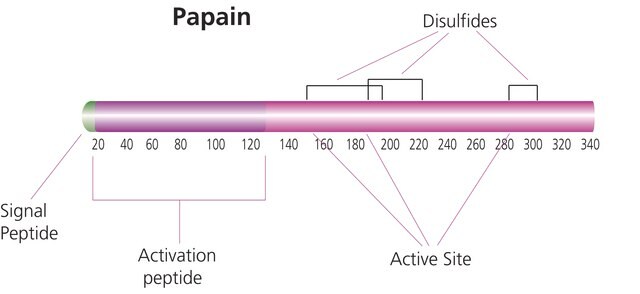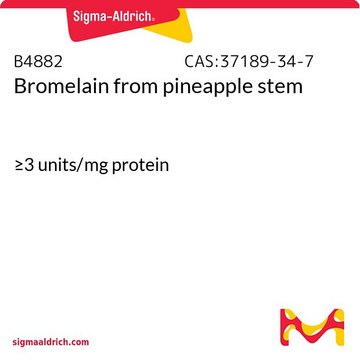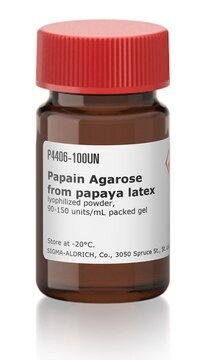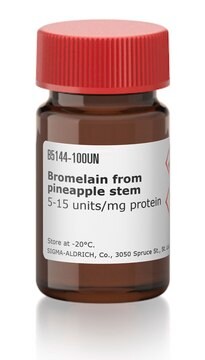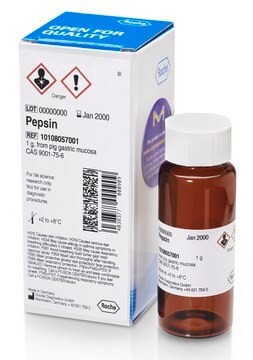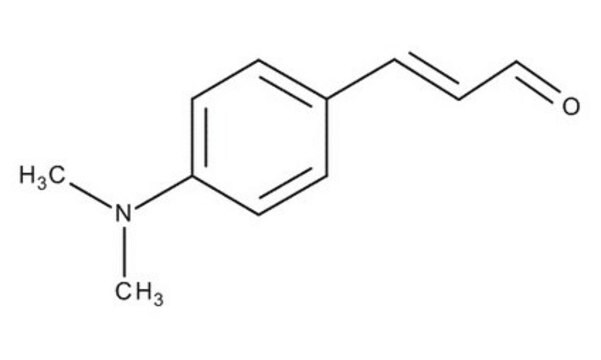10108014001
Roche
Papain
from Carica papaya
Synonyme(s) :
cystein protease, papain
Se connecterpour consulter vos tarifs contractuels et ceux de votre entreprise/organisme
About This Item
Produits recommandés
Source biologique
papaya
Niveau de qualité
Forme
suspension
Activité spécifique
30 U/mg
~30 units/mg protein (At 25 °C with BAEE as the substrate.)
Poids mol.
23 kDa
Conditionnement
pkg of 10 mL (100 mg)
Fabricant/nom de marque
Roche
Concentration
10-100 mg/mL
pH optimal
6.0-7.0
Conditions d'expédition
wet ice
Description générale
Papain is a cysteine protease of the papain family. It is a single chain protein. The molecular weight of papain is 23 kDa. Papain is composed of two structural domains and a cleft between them, which consists of the active site.
Application
Papain has been used in the digestion of various brain cells.
Use Papain for the complete proteolytic cleavage of proteins, limited hydrolysis of native immunoglobulins, and tissue dissociation (together with collagenase, esterase, and trypsin). The enzyme solubilizes integral membrane proteins and produces glycopeptides from purified proteoglycans. The addition of cysteine (approximately 0.5% [w/v]) is essential for enzyme activity.
Actions biochimiques/physiologiques
Papain exhibits proteolytic activity against amide links, amino acid esters, peptides, proteins. It mainly cleaves peptide bonds containing amino acids such as lysine, arginine and residues succeeding phenylalanine. It can catalyze several reactions, such as hydrolysis, transferase action, specificity and acyl-enzyme intermediate.
Caractéristiques et avantages
Inhibitors: SH-blocking reagents, iodoacetic acid, iodoacetamide, TPCK, TLCK, leupeptin, a2-macroglobulin, E-64, PMSF, and antipain, Hg2+, and other heavy metals
Forme physique
Suspension, crystalline, nonsterile
Notes préparatoires
Working concentration: 0.05 to 0.5 mg/ml
Stockage et stabilité
Store at 2 to 8 °C. (a decrease in activity of 20% may occur within 6 months)
Autres remarques
For life science research only. Not for use in diagnostic procedures.
Code de la classe de stockage
12 - Non Combustible Liquids
Classe de danger pour l'eau (WGK)
nwg
Point d'éclair (°F)
does not flash
Point d'éclair (°C)
does not flash
Faites votre choix parmi les versions les plus récentes :
Déjà en possession de ce produit ?
Retrouvez la documentation relative aux produits que vous avez récemment achetés dans la Bibliothèque de documents.
Les clients ont également consulté
John S. White and Dorothy C. White
Source Book of Enzymes null
Spatiotemporal ablation of CXCR2 on oligodendrocyte lineage cells: Role in myelin repair
Liu L, et al.
Neurology? neuroimmunology & neuroinflammation, 2(6), e174-e174 (2015)
Bortezomib and metformin opposingly regulate the expression of hypoxia-inducible factor alpha and the consequent development of chemotherapy-induced painful peripheral neuropathy
Ludman T and Melemedjian O K
Molecular Pain, 15, 1744806919850043-1744806919850043 (2019)
LIM Kinase, a Newly Identified Regulator of Presynaptic Remodeling by Rod Photoreceptors After Injury.
Wang W and Townes-Anderson E
Investigative Ophthalmology & Visual Science, 56(13), 7847-7858 (2015)
The structure of papain
Advances in Protein Chemistry, 25, 79-115 (1971)
Notre équipe de scientifiques dispose d'une expérience dans tous les secteurs de la recherche, notamment en sciences de la vie, science des matériaux, synthèse chimique, chromatographie, analyse et dans de nombreux autres domaines..
Contacter notre Service technique
